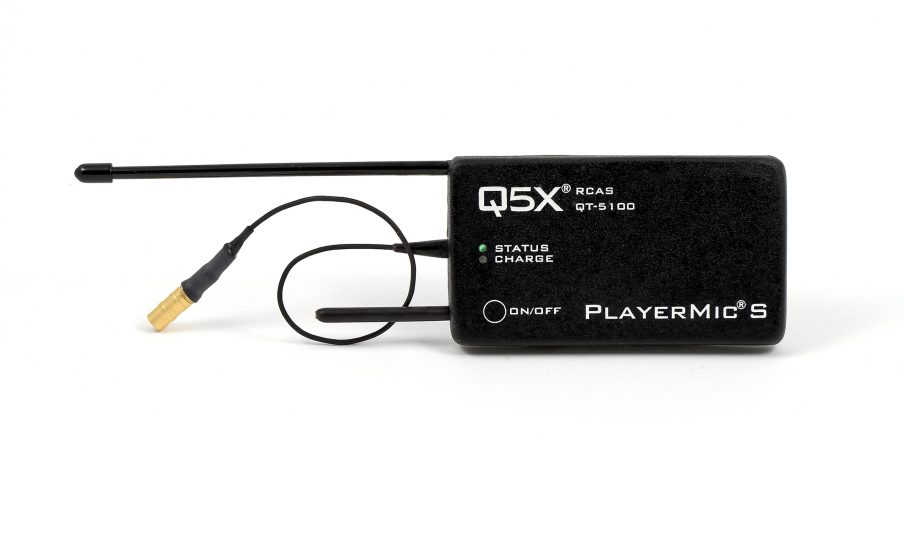NBA Player Audio Hits 10-Year Milestone
Wiring the athletes, officials for sound has spread to the NFL, NHL, other leagues
It has been a full decade for sound-wired major-league basketball players. The first Quantum5X PlayerMic was developed by the London, ON-based wireless company specifically for the NBA in 2007. Since then, it has become a staple of NBA broadcasts on ESPN, ABC, Turner Sports, CBS, and NBA Network.

The QT-5100 PlayerMic S model transmitter is part of the Quantum5X player package supplied by Bexel.
The player packages — comprising five QT-5100 PlayerMic S model transmitters and one QR-2100 dual-channel receiver, Countryman B6 lavaliere microphone elements, and related accessories — have been put together by Bexel Global Broadcast Solutions for the NBA for the past four years. Five transmitters — the S model was introduced last year and is the smallest transmitter Q5X has produced — are used per game: one for each of the two jerseys a player from each team will wear during a game, plus a spare.
“The transmitters can be controlled and monitored remotely for things like frequency adjustments and checking battery levels,” says Q5X CEO Paul Johnson, noting that once they’re on the court we can’t get at them again.”
Sound from the PlayerMics are recorded to hard drives on the broadcast truck and fashioned on the fly into clips shown within minutes of the action’s taking place. That’s a guard against foul language reaching the air. However, Johnson notes, the league’s main concern from the beginning has been player safety, which drove design: the PlayerMic bodypack is in a rubberized, flexible case weighing less than 2 oz. and only a third of an inch thick, so falls on the hardwood courts won’t result in injuries.
Bexel Covers the Field
Bexel now has 35 of the QT-5100 PlayerMic and PlayerMic S units out with NBA teams, with the S model tuned for the RF spectrum’s constrained future, from 525 MHz to 600 MHz. The unit has been changing with the times: Bexel provides RF tuning in four blocks, between 470 MHz and 691 MHz, but that will be capped at 614 MHz in the next couple of years as the 600 MHz band is reallocated following the FCC auction completed this year.
In addition, Bexel has been providing the league with coach and ref wireless systems. These use Lectrosonics DB and DBA digital transmitters, for which the company also provides RF tuning. The Lectrosonics digital transmitters are encrypted. (Analog transmitters, such as the PlayerMic, cannot be encrypted, but their audio is not used live on broadcasts.) The emphasis on security stems from the need to protect play tactics and strategies. Ted Marvin, the engineer in charge of player audio at Bexel, says the focus was also on inclusion of a virtually foolproof mute button designed by Lectrosonics specifically to meet the league’s requirements.
This category has seen some equipment flux: the original Lectrosonics 700 Series product used for it was discontinued nearly a decade ago; a subsequent Zaxcom product was also discontinued. The newer Lectrosonics DBa version, which came into use this season, has a smaller transmitter and an integrated mute switch that Lectrosonics customized for the NBA that makes it easier to activate and to determine status by feel. They also wrote custom firmware creating an easily read LED status indicator to signal the mute status.
A Big NBA Niche
On-player audio has spawned a huge niche in the sport and has been integrated into the individual and collective branding strategies around players and teams. The NBA maintains its own online home for player sound. However, what strikes Marvin most is the infrastructure that has been built up around the idea.
“There are platforms and personnel dedicated just to the player audio from games,” he says. “The drives the sound is recorded to, the people who are taking that and building packages out of it as the game goes on, the league rep who listens and approves the audio to be used. The ingest procedures for the audio coming into the truck. It’s really a pretty big operation just for that sound.”
Bexel supplied some of the original Zaxcom RF systems used by the NFL when it began using player audio in 2010, after it moved the vulnerable umpire — who had been wearing the microphone that caught most of the scrimmage sound — to safer ground. Since then, the league has placed microphones and transmitters on two players in each game. That audio is contained completely within the NFL’s ecosystem, ported to the broadcast networks by the league’s own mixers in each stadium.
The NHL also has used related systems, with Q5X and Lectrosonics components, provided by Bexel. That audio is collected through NHL Studios and used mainly in postproduction packages.
But Marvin says the next field of dreams for regular use of onfield audio (MLB uses the technique for “event” games, such as the All-Star Game) will be in MLS and rugby. “We’re really looking to expand the idea to as many sports as possible,” he explains. “Once people get used to hearing what a game sounds like from the field or the court, they can’t get enough of it.”
Tags: audio, Bexel, NBA, player mics, Quantum5X,

No comments yet. You should be kind and add one!
The comments are closed.